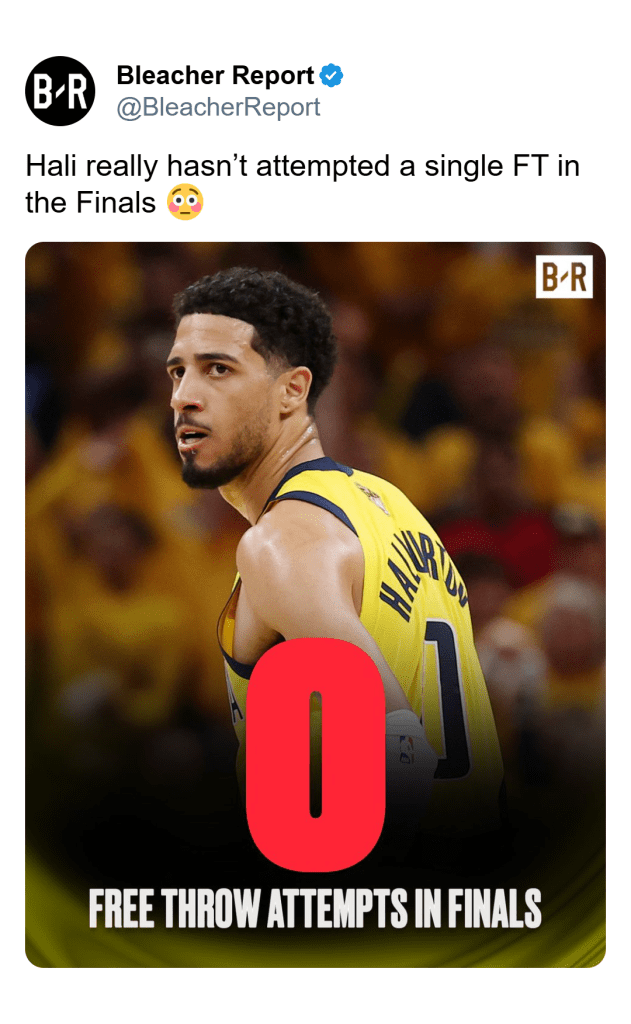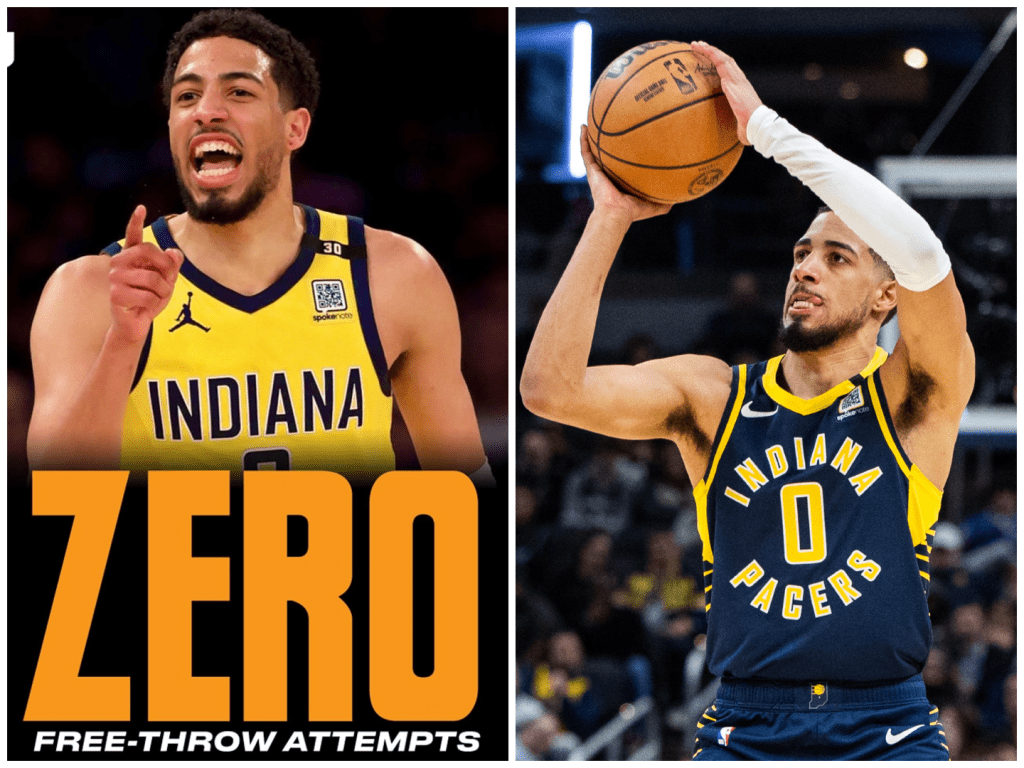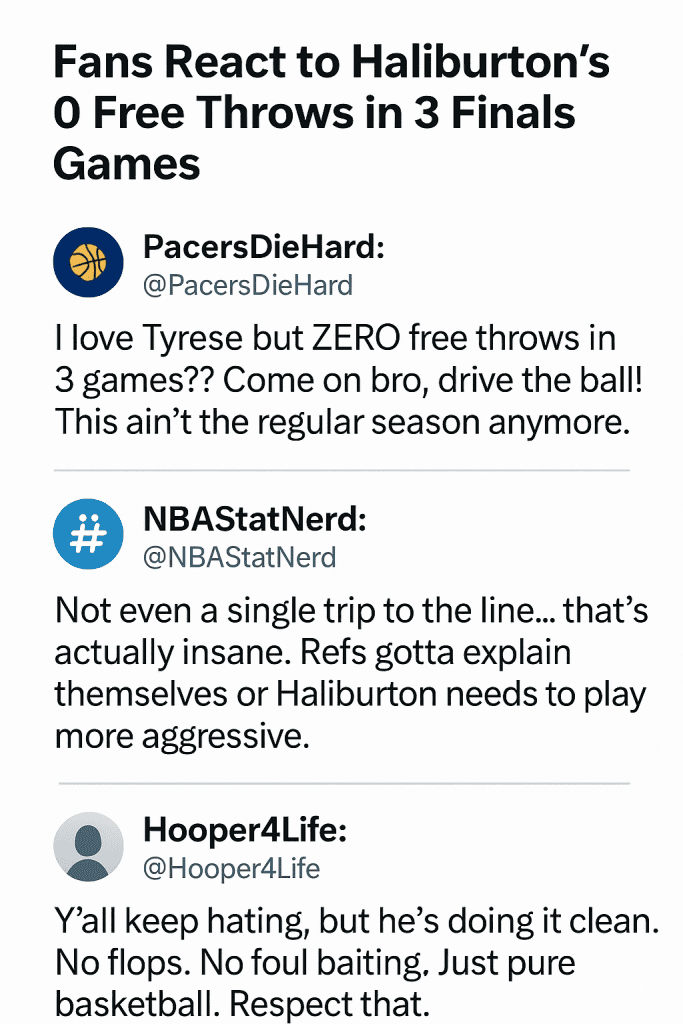
Zero Free Throws in Three NBA Finals Games? Why Tyrese Haliburton’s Clean Slate Is Turning Heads and Sparking Big Questions
Tyrese Haliburton has had one of the most fascinating runs in the 2025 NBA Playoffs. He’s been clutch, composed, and smart on the floor. But during the first three games of the NBA Finals, something strange happened—something no one expected from a star point guard in today’s NBA: he went three full games without a single free throw attempt.
That’s right. In three high-intensity, physically demanding Finals matchups, Tyrese Haliburton hasn’t stepped to the line even once. In a league where star players regularly shoot 8–10 free throws a night just by driving into contact, this is shocking. It’s not just rare — it’s almost unheard of. And it’s got fans, analysts, and players all talking.
This isn’t about free throw percentage or whether he missed opportunities. This is about the fact that he hasn’t even been given the chance. It opens up a lot of questions: Is he being too passive? Is the defense just that good? Are the refs swallowing their whistles? Or is it something deeper?
Zero Free Throws: What’s Really Going On?

Let’s start with what we know. Tyrese Haliburton is not a passive player. He’s known for his court vision, crafty passing, and ability to knock down shots from anywhere on the floor. He’s also not afraid to drive into the paint. But in these Finals, it seems like something’s different.
The Thunder defense deserves credit. They’ve packed the paint, clogged driving lanes, and made life uncomfortable for Haliburton and the Pacers. Their bigs are helping early, their perimeter guys are staying home, and they’re forcing Haliburton to either pass early or settle for outside shots.
But even with all that, no free throw attempts? Not one? That’s hard to wrap your head around. Especially considering the level of physical play happening in the Finals. Usually, a few bumps, body contact, or even late-game situations lead to at least a couple of trips to the line.
And this isn’t just a random stat. It could be the difference in a close game. In Game 1, Haliburton hit a huge step-back jumper with 0.3 seconds left to give Indiana a thrilling 111–110 win. That’s the kind of clutch shot that earns headlines. But imagine if he had gone to the line a few times earlier in that game — the Pacers might not have needed heroics at all.
Game 2 and Game 3 were rougher. The Thunder adjusted, got more physical, and Indiana struggled. Haliburton’s scoring dipped, his touches decreased, and still, zero trips to the charity stripe. Not even on a drive, a bump, or a late-game possession. It’s as if the whistle just stopped existing when he had the ball.
After Game 3, fans were buzzing. Some praised Haliburton for playing a “clean” game and not baiting refs like some other stars. On Reddit, people called him “an ethical hooper,” joking that he was the last of a dying breed. Others were more critical, saying that it showed a lack of aggression — that a Finals-level guard should be living at the free throw line, especially when shots aren’t falling.
Even Kendrick Perkins weighed in, saying on-air, “Tyrese gotta play like a superstar. You can’t be scared to go get contact. This is the Finals, not a preseason scrimmage.”
Haliburton himself didn’t shy away from the topic. In postgame interviews, he admitted he needed to be better. “I’ve got to figure out how to get going earlier,” he said. “They’re taking away the paint, and I’ve got to find ways to stay aggressive and still make plays.” That kind of accountability is refreshing, but it doesn’t make the stat any less surprising.
What’s maybe most surprising is that this isn’t just some fluke. This is three straight games in the biggest stage of the year. And in those games, stars are expected to rise. They get the ball more, the spotlight’s hotter, and the whistles usually come easier — at least for guys who force the issue.
Compare that to Shai Gilgeous-Alexander, the Thunder’s star, who has already attempted over 25 free throws in the same stretch. He’s getting into the body of defenders, drawing fouls, and making the most of every drive. That doesn’t make Haliburton less talented — but it shows the difference in approach.

Is it coaching? Strategy? Fatigue? Or maybe just Haliburton trying to play within the system? Either way, it’s a storyline that’s now impossible to ignore.
This is also part of a bigger trend. The Pacers as a team aren’t getting to the line much either. The Thunder have clearly made a decision to wall off the paint and force Indiana into jumpers. It’s worked so far, and the Pacers are going to have to adjust if they want to stay alive in the series.
For Haliburton, that might mean taking some hits, attacking the rim even when it’s clogged, and maybe even flopping a little — just enough to force refs to call something. That’s the ugly truth of playoff basketball: sometimes you have to sell the contact.
Of course, no one wants Haliburton to change his game completely. One of his best qualities is his control, his calm, and his ability to keep the team steady. But the Finals are not about composure — they’re about results. And if he wants to truly lead his team to a title, he might have to get a little uncomfortable.
What Happens Next?
There’s still time. The Finals aren’t over. The Pacers could bounce back. Haliburton could explode for a 30-point game and hit 10 free throws in the process. But if that doesn’t happen, if this trend continues, the conversations will only get louder.
No free throws in three Finals games might seem like a small thing — but it says a lot. It says something about how Haliburton is playing, how he’s being guarded, and how he’s being officiated. It also says something about how hard it is to win on this stage if you’re not getting the benefit of the whistle.
Haliburton is still young. He’s still growing. And this moment could be the one that pushes him to evolve, to find that next gear, and to become the kind of player who doesn’t just make big shots — but forces the game to bend around him.
Because in the NBA Finals, you don’t just play the game — you shape it.
